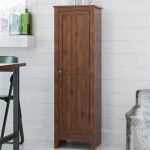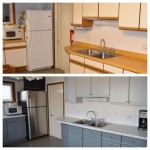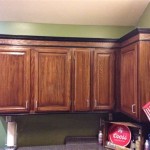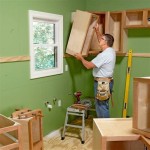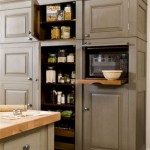How To Make Shaker Cabinet Doors With a Router Jig
Shaker cabinet doors, characterized by their clean lines and recessed flat panel, are a staple of classic and contemporary design. Constructing these doors involves creating a frame, typically composed of four pieces of wood (two stiles and two rails), and fitting a panel within this frame. While various methods exist for creating the mortise and tenon or cope and stick joinery required for the frame, using a router jig offers a precise and efficient method for achieving consistent, professional-looking results. This article will detail the process of crafting shaker cabinet doors using a router jig, focusing on the key steps for achieving accuracy and clean cuts.
The router jig, in this context, refers to a template or guide designed to control the router's path, ensuring that the resulting cuts are consistent and accurate. These jigs can be purchased commercially or fabricated in a workshop. Regardless of the source, the jig needs to be carefully calibrated to the desired dimensions of the cabinet door frame components.
Preparing the Wood and Determining Dimensions
The first crucial step involves selecting and preparing the wood for both the frame and the panel. Hardwoods, such as maple, cherry, or oak, are typically preferred for the frame due to their durability and ability to hold detail. Softwoods, like pine, can be used, but require careful handling to prevent damage. The panel can be made from solid wood, plywood, or MDF (Medium-Density Fiberboard), depending on the desired aesthetic and budget.
Accurate measurements are paramount. Begin by determining the overall dimensions of the desired cabinet door. These dimensions will dictate the length of the stiles and rails. The stiles are the vertical pieces of the frame, while the rails are the horizontal pieces. The length of the rails will be slightly shorter than the overall door width, accounting for the tenons or cope, which will fit into the mortises or stick cuts on the stiles.
Consider the width of the frame members. A common width is 2 1/4 inches, but this can be adjusted to suit specific design preferences. This width will also influence the selection of router bits and the design of the router jig. Once the dimensions are finalized, cut the stiles and rails to the appropriate lengths. Ensure the pieces are square and free of any imperfections that could compromise the integrity of the finished door.
For the panel, measure the opening within the frame. The panel should be slightly smaller than the opening to allow for expansion and contraction due to changes in humidity. A common practice is to subtract 1/8 inch from both the length and width of the opening to provide this necessary clearance. Cut the panel to the determined dimensions.
Constructing or Acquiring a Router Jig
The heart of this process is the router jig. Pre-made jigs designed specifically for shaker door construction are available from woodworking suppliers. Alternatively, a jig can be fabricated in the workshop using plywood or MDF. A homemade jig offers the advantage of being tailored to specific router bit sizes and frame member widths.
A typical jig for shaker door construction will have two main components: a template for cutting the mortises (or stick cuts) on the stiles and a template for creating the tenons (or cope cuts) on the rails. The mortise template will have an opening that matches the size and shape of the desired mortise. The tenon template will have an opening that allows the router to create the tenon profile, typically with a shoulder that fits flush against the stile after assembly.
When creating a homemade jig, precision is key. Use accurate measuring tools and a router table to ensure the openings are square and consistent. The jig should also be sturdy enough to withstand repeated use without warping or shifting. Secure the jig to the workpiece using clamps or double-sided tape to prevent movement during routing.
Whether using a purchased or homemade jig, it is imperative to test the setup on scrap wood before committing to the final pieces. This allows for fine-tuning the jig or adjusting the router bit depth to achieve the desired fit. Careful calibration at this stage will prevent costly errors later on.
Routing the Joinery and Assembling the Frame
Once the wood is prepared and the router jig is ready, the routing process can begin. The specific steps will vary depending on the design of the jig and the type of joinery being used (mortise and tenon or cope and stick). However, the general principles remain the same: secure the workpiece to the jig, adjust the router bit depth, and carefully guide the router along the template.
For mortise and tenon joinery, begin by routing the mortises on the stiles. Secure the stile to the mortise template, ensuring it is properly aligned. Use a plunge router with a straight bit or a spiral upcut bit. Gradually increase the depth of cut with each pass, avoiding taking too much material at once, which can lead to tear-out or bit chatter. Once the mortise is complete, repeat the process for the other stile.
Next, route the tenons on the rails. Secure the rail to the tenon template and use a router bit with a bearing guide. The bearing will ride along the edge of the template, creating the tenon profile. Multiple passes may be necessary to achieve the desired tenon thickness. Ensure the shoulders of the tenons are square and clean for a tight fit against the stiles.
For cope and stick joinery, the process is similar, but the router bits and templates are designed to create a matching profile on both the stiles and rails. Cope and stick joinery often uses a specialized router bit set consisting of a cope bit and a stick bit. The cope bit creates the profile on the ends of the rails, while the stick bit creates the corresponding profile along the inside edges of the stiles and rails.
After routing all the joinery, dry-fit the frame members to ensure a proper fit. The tenons should fit snugly into the mortises, or the cope and stick profiles should align perfectly. Make any necessary adjustments before applying glue. Apply a thin layer of wood glue to the tenons or cope surfaces and clamp the frame together. Ensure the frame is square during clamping using a framing square or by measuring the diagonals.
Allow the glue to dry completely according to the manufacturer's instructions. Once the glue is dry, remove the clamps and clean up any excess glue squeeze-out. The frame is now ready to accept the panel.
Installing the Panel and Finishing
With the frame assembled, the final step is to install the panel. As mentioned earlier, the panel should be slightly smaller than the opening in the frame to allow for expansion and contraction. There are several methods for securing the panel within the frame. One common method is to use space balls or rubber bumpers. These small, flexible spacers are placed around the perimeter of the panel, providing a cushion between the panel and the frame. The space balls allow the panel to float freely within the frame, preventing it from binding or cracking as the wood expands and contracts.
Another method is to use small brad nails or staples to secure the panel in place. However, this method is less desirable as it restricts the panel's movement and can lead to cracking. If using nails or staples, be sure to pre-drill pilot holes to prevent splitting the wood.
Once the panel is installed, the cabinet door is ready for finishing. Sand the entire door to create a smooth, even surface. Start with a coarser grit sandpaper (e.g., 120 grit) and gradually work your way up to a finer grit (e.g., 220 grit). Be sure to sand with the grain of the wood to avoid scratching. Remove all sanding dust with a tack cloth or vacuum.
Apply the desired finish to the door. This could be paint, stain, varnish, or a combination thereof. For painted doors, prime the surface first to ensure proper adhesion of the paint. Apply multiple thin coats of finish, allowing each coat to dry completely before applying the next. Lightly sand between coats to remove any imperfections. For stained doors, apply the stain evenly and wipe off any excess. Seal the stain with a clear topcoat to protect it from scratches and moisture.
With the finish applied and dry, the shaker cabinet door is complete. Install hinges and a knob or pull, and the door is ready to be installed on the cabinet.

Tongue And Groove Rail Stile Router Bits Shaker Style Doors Making

Making Cabinet Doors Using A Router Table Rogue Engineer

Make Cabinet Doors With A Router Free Project Plan

Never Using A Table Saw For This Again Shaker Style Cabinet Doors With Router

Make Mission Or Shaker Style Doors With Tongue Groove Router Bit Set Infinity Cutting Tools

How To Make Cabinet Doors With Rail And Stile Router Bits Skill Builder

The Easiest Way To Diy Shaker Cabinet Doors Fun Home Building

Giving Plain Flat Doors A Diffe Look With Simple Jig

Making Cabinet Doors Using A Router Table Rogue Engineer

Diy Shaker Cabinet Doors How To Make Your Own For Less Farmhouseish
Related Posts

